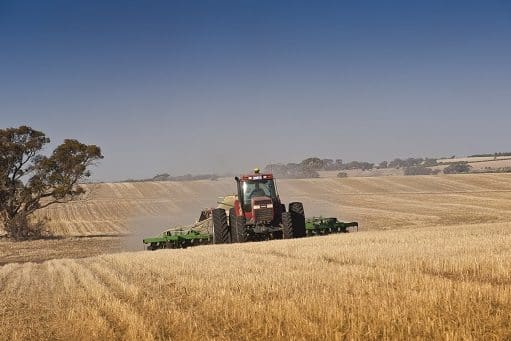GRAIN growers are advised to take extra care with seed and fertiliser placement this year in areas where there are dry sowing conditions.
Dry soils increase the risk of harm to germinating seeds by fertiliser, especially when it is placed too close to the seed or at rates that are too high.
Norton Agronomy director, Dr Rob Norton, said growers needed to be mindful of the soil conditions in their paddocks when applying fertiliser at sowing.
“The dry lead in to winter sowing in 2018 means last year’s strategy might not be safe this year,” he said.

Dr Rob Norton says growers need to be mindful of the soil conditions in their paddocks when applying fertiliser at sowing. (Photo: Evan Collis)
Dr Norton, who chairs the Grains Research and Development Corporation’s eXtensionAUS crop nutrition community of practice and is a GRDC Southern Regional Cropping Solutions Network member, encourages growers to use a seed damage calculator, available at goo.gl/NT8vmB, to check how much fertiliser they can apply with seed through the same chute.
The calculator doesn’t address fertiliser placed below or to the side of seed, but Dr Norton says separation of seed and fertiliser at around 3-5 centimetres is usually enough distance to protect the seed.
“The risk of fertiliser damage increases with drier and sandier soils,” Dr Norton said.
“Conditions that cause stress or slow germination prolongs fertiliser-seed contact, and this increases the chance of damage.”
Crop type is another factor, with canola and lentils being more sensitive, while wheat and barley are relatively tolerant.
“The order of sensitivity for crop species can vary for fertiliser type, but in general, the order from most to least sensitive in major grain crops is canola, followed by lentils, peas, oats, wheat and then barley.”
Fertilisers can affect germinating seeds in at least two ways, with the first relating to salt index. Most fertilisers are salts and as such, too much fertiliser salt can ‘burn’ the seedling or stop seedlings from absorbing water.
Nitrogen and potassium fertilisers tend to have a higher salt index than phosphorus fertilisers. Sulphate forms tend to have lower salt indexes.
Ammonia formation potential is the second consideration.
Dr Norton said free ammonia could be toxic to seed.
“Placing urea-containing fertilisers in-furrow is risky because they produce ammonia,” he said.
“A fertiliser with polymer coatings or urease inhibitors may slow the rate of ammonia production enough to protect seed. These fertilisers are still considered risky to place near seeds.”
In terms of placement, Dr Norton said the safe rate of fertiliser per hectare increased as row space narrowed.
“Closer row spacing ‘dilutes’ fertiliser over the length of row.”
Machinery configuration, such as twin chuting systems which separate seed and fertiliser, can assist in protecting the seed. Fertiliser is placed in bands to the side or below the seed bands, and separation of 3-5cm is usually enough to protect seed.
Dr Norton said the more scatter there was between seed and fertiliser, the more fertiliser can be safely applied.
“The concept of seed bed utilisation (SBU) addresses this factor. SBU is the proportion of row width occupied by seed row,” he said.
“It’s the seed row width divided by the tyne spacing or row width – the wider the seed row for a specific row width, the greater the SBU. As SBU increases so does the safe rate of in-furrow fertilisation.”
Dr Norton said the seed damage calculator included several liquid fertilisers.
“As a general rule, use the same maximum nitrogen or phosphorus rates as for solid products, based on nutrient concentration,” he said.
“Treat urea/ammonium nitrate like urea. Treat ammoniated phosphoric acid the same as MAP.”
Source: GRDC
More information on seed and fertiliser placement in dry soils is available on the eXtensionAus website at goo.gl/ZuYKPJ.
Tables for fertiliser/crop combination thresholds are available on the International Plant Nutrition Institute website at http://anz.ipni.net/article/ANZ-3074.
Grain Central: Get our free daily cropping news straight to your inbox – Click here

HAVE YOUR SAY